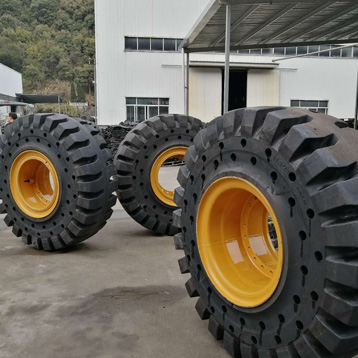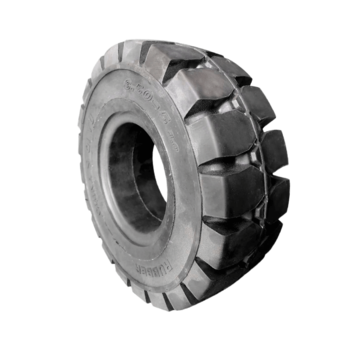In industrial operations that rely on forklifts for material handling, the choice of tires plays a significant role in ensuring efficient, safe, and cost-effective performance. The press-on solid tire is a popular option for businesses looking to enhance the overall performance and longevity of their forklifts. Unlike pneumatic tires, which are inflated with air, press-on solid tires are made from solid rubber and are designed to provide unique benefits in terms of durability, safety, and maintenance. This article explores the key characteristics of the press-on solid tire for electric forklift truck, shedding light on its features and how it contributes to a more efficient and reliable operation.

1. Durability and Long Lifespan
One of the notable characteristics of the press-on solid tire for electric forklift truck is its impressive durability. Unlike pneumatic tires, solid tires are not susceptible to punctures or deflation. Since the tire is made from a single, solid piece of rubber, it can withstand rough handling, sharp objects, and harsh conditions typically found in industrial environments. This makes the press-on solid tire for electric forklift truck an ideal choice for warehouses, factories, or distribution centers where forklifts frequently encounter debris, nails, or broken glass that could cause punctures in traditional tires.
Moreover, the solid rubber construction ensures that the tire maintains its shape and functionality even after prolonged use. The press-on solid tire for electric forklift truck has a longer lifespan than many other types of tires, which helps reduce the frequency of tire replacements and the associated costs.
2. Low Maintenance Requirements
The press-on solid tire for electric forklift truck is known for its low-maintenance nature. One of the main drawbacks of pneumatic tires is the need for regular air pressure checks and inflation. Over time, pneumatic tires can lose air, requiring constant attention to maintain performance. In contrast, the press-on solid tire for electric forklift truck requires no air, eliminating the need for monitoring tire pressure or dealing with flats. This significantly reduces maintenance tasks and downtime.
Additionally, the solid construction of the tire minimizes wear and tear, further contributing to its low-maintenance characteristics. Operators can focus on other aspects of forklift operation without worrying about tire-related issues, which bring about improved productivity and reduced operational costs.
3. Consistent Performance in All Conditions
A major advantage of the press-on solid tire for electric forklift truck is its ability to deliver consistent performance under various operational conditions. Since solid tires are not affected by changes in air pressure or punctures, they provide stable performance throughout their lifespan. This ensures that the forklift operates reliably, even in challenging environments with varying temperatures, humidity levels, or rough flooring.
For instance, the press-on solid tire for electric forklift truck performs well in both indoor and outdoor environments. Whether the forklift is moving heavy loads inside a warehouse or navigating uneven surfaces in an outdoor yard, the tire's consistent performance remains unaffected by external factors. This makes it a highly versatile solution for businesses that require flexibility in their operations.
4. Increased Load-Bearing Capacity
The press-on solid tire for electric forklift truck is designed to handle substantial loads, making it ideal for heavy-duty applications. Solid rubber tires have a higher load-bearing capacity than many pneumatic tires, allowing the forklift to carry heavier loads without compromising stability or performance. This characteristic is particularly important in industries such as manufacturing, logistics, and construction, where forklifts are required to move bulky or weighty materials.
The solid nature of the tire also ensures that the forklift's weight is evenly distributed across the tire surface, which enhances the machine's overall stability. Operators can handle heavier loads with greater confidence, improving operational safety.
 View More
View More
 View More
View More
 View More
View More
 View More
View More
 View More
View More
 View More
View More
 View More
View More
 View More
View More
 View More
View More
 View More
View More
 View More
View More
 View More
View More